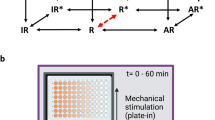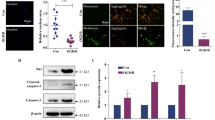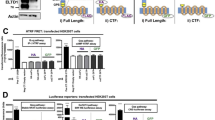Abstract
Aim:
To understand the mechanism of the transactivation of the epidermal growth factor receptor (EGFR) mediated by the adenosine A1 receptor (A1R).
Methods:
Primary cultured rat cortical neurons subjected to oxygen-glucose deprivation (OGD) and HEK293/A1R cells were treated with the A1R-specific agonist N6-cyclopentyladenosine (CPA). Phospho-EGFR, Akt, and ERK1/2 were observed by Western blot. An interaction between EGFR and A1R was detected using immunoprecipitation and immunocytochemistry.
Results:
The A1R agonist CPA causes protein kinase B (Akt) activation and protects primary cortical neurons from oxygen-glucose deprivation (OGD) insult. A1R and EGFR co-localize in the membranes of neurons and form an immunocomplex. A1R stimulation induces significant EGFR phosphorylation via a PI3K and Src kinase signaling pathway; this stimulation provides a neuroprotective effect in cortical neurons. CPA leads to sustained phosphorylation of extracellularly regulated kinases 1 and 2 (ERK1/2) in cortical neurons, but only to transient phosphorylation in HEK 293/A1R cells. The response to the A1R agonist is mediated primarily through EGFR transactivation that is dependent on pertussis toxin (PTX)-sensitive Gi protein and metalloproteases in HEK 293/A1R.
Conclusion:
A1R-mediated EGFR transactivation confers a neuroprotective effect in primary cortical neurons. PI3 kinase and Src kinase play pivotal roles in this response.
Similar content being viewed by others
Log in or create a free account to read this content
Gain free access to this article, as well as selected content from this journal and more on nature.com
or
References
Wardas J . Neuroprotective role of adenosine in the NS. Pol J Pharmacol 2002; 54: 313–26.
Tomaselli B, Nedden SZ, Podhraski V, Baier-Bitterlich G . p42/44 MAPK is an essential effector for purine nucleoside-mediated neuroprotection of hypoxic PC12 cells and primary cerebellar granule neurons. Mol Cell Neurosci 2008; 38: 559–68.
Seidel MG, Klinger M, Freissmuth M, Holler C . Activation of mitogen-activated protein kinase by the A(2A)-adenosine receptor via a rap1-dependent and via a p21(ras)-dependent pathway. J Biol Chem 1999; 274: 25833–41.
Dudek H, Datta SR, Franke TF, Birnbaum MJ, Yao R, Cooper GM, et al. Regulation of neuronal survival by the serine-threonine protein kinase Akt. Science 1997; 275: 661–5.
Germack R, Dickenson JM . Activation of protein kinase B by the A(1)-adenosine receptor in DDT(1)MF-2 cells. Br J Pharmacol 2000; 130: 867–74.
Gervitz LM, Nalbant D, Williams SC, Fowler JC . Adenosine-mediated activation of Akt/protein kinase B in the rat hippocampus in vitro and in vivo. Neurosci Lett 2002; 328: 175–9.
Shah BH, Catt KJ . A central role of EGF receptor transactivation in angiotensin II-induced cardiac hypertrophy. Trends Pharmacol Sci 2003; 24: 239–44.
Dewar BJ, Gardner OS, Chen CS, Earp HS, Samet JM, Graves LM . Capacitative calcium entry contributes to the differential transactivation of the epidermal growth factor receptor in response to thiazolidinediones. Mol Pharmacol 2007; 72: 1146–56.
Gosens R, Nelemans SA, Grootte Bromhaar MM, McKay S, Zaagsma J, Meurs H . Muscarinic M3-receptors mediate cholinergic synergism of mitogenesis in airway smooth muscle. Am J Respir Cell Mol Biol 2003; 28: 257–62.
Kong KC, Billington CK, Gandhi U, Panettieri RA Jr, Penn RB . Cooperative mitogenic signaling by G protein-coupled receptors and growth factors is dependent on G(q/11). FASEB J 2006; 20: 1558–60.
Wetzker R, Bohmer FD . Transactivation joins multiple tracks to the ERK/MAPK cascade. Nat Rev Mol Cell Biol 2003; 4: 651–7.
Ji Y, Pang PT, Feng L, Lu B . Cyclic AMP controls BDNF-induced TrkB phosphorylation and dendritic spine formation in mature hippocampal neurons. Nat Neurosci 2005; 8: 164–72.
Cao Y, Sun WC, Jin L, Xie KQ, Zhu XZ . Activation of adenosine A1 receptor modulates dopamine D1 receptor activity in stably cotransfected human embryonic kidney 293 cells. Eur J Pharmacol 2006; 548: 29–35.
Nair VD, Sealfon SC . Agonist-specific transactivation of phosphoinositide 3-kinase signaling pathway mediated by the dopamine D2 receptor. J Biol Chem 2003; 278: 47053–61.
Zhang WY, Liu HQ, Xie KQ, Yin LL, Li Y, Kwik-Uribe CL, et al. Procyanidin dimer B2 [epicatechin-(4beta-8)-epicatechin] suppresses the expression of cyclooxygenase-2 in endotoxin-treated monocytic cells. Biochem Biophys Res Commun 2006; 345: 508–15.
Dunwiddie TV, Masino SA . The role and regulation of adenosine in the central nervous system. Annu Rev Neurosci 2001; 24: 31–55.
Prenzel N, Zwick E, Daub H, Leserer M, Abraham R, Wallasch C, et al. EGF receptor transactivation by G-protein-coupled receptors requires metalloproteinase cleavage of proHB-EGF. Nature 1999; 402: 884–8.
Jorissen RN, Walker F, Pouliot N, Garrett TP, Ward CW, Burgess AW . Epidermal growth factor receptor: mechanisms of activation and signalling. Exp Cell Res 2003; 284: 31–53.
Stephens L, Anderson K, Stokoe D, Erdjument-Bromage H, Painter GF, Holmes AB, et al. Protein kinase B kinases that mediate phosphatidylinositol 3,4,5-trisphosphate-dependent activation of protein kinase B. Science 1998; 279: 710–4.
Coutant A, Rescan C, Gilot D, Loyer P, Guguen-Guillouzo C, Baffet G . PI3K-FRAP/mTOR pathway is critical for hepatocyte proliferation whereas MEK/ERK supports both proliferation and survival. Hepatology 2002; 36: 1079–88.
Mifune M, Ohtsu H, Suzuki H, Nakashima H, Brailoiu E, Dun NJ, et al. G protein coupling and second messenger generation are indispensable for metalloprotease-dependent, heparin-binding epidermal growth factor shedding through angiotensin II type-1 receptor. J Biol Chem 2005; 280: 26592–9.
Liu J, Liao Z, Camden J, Griffin KD, Garrad RC, Santiago-Perez LI, et al. Src homology 3 binding sites in the P2Y2 nucleotide receptor interact with Src and regulate activities of Src, proline-rich tyrosine kinase 2, and growth factor receptors. J Biol Chem 2004; 279: 8212–8.
Dickenson JM, Blank JL, Hill SJ . Human adenosine A1 receptor and P2Y2-purinoceptor-mediated activation of the mitogen-activated protein kinase cascade in transfected CHO cells. Br J Pharmacol 1998; 124: 1491–9.
Linden J. Molecular approach to adenosine receptors: receptor-mediated mechanisms of tissue protection. Annu Rev Pharmacol Toxicol 2001; 41: 775–87.
de Mendonca A, Sebastiao AM, Ribeiro JA . Adenosine: does it have a neuroprotective role after all? Brain Res Brain Res Rev 2000; 33: 258–74.
Downward J . Mechanisms and consequences of activation of protein kinase B/Akt. Curr Opin Cell Biol 1998; 10: 262–7.
Gardner OS, Dewar BJ, Graves LM . Activation of mitogen-activated protein kinases by peroxisome proliferator-activated receptor ligands: an example of nongenomic signaling. Mol Pharmacol 2005; 68: 933–41.
Shah BH, Farshori MP, Jambusaria A, Catt KJ . Roles of Src and epidermal growth factor receptor transactivation in transient and sustained ERK1/2 responses to gonadotropin-releasing hormone receptor activation. J Biol Chem 2003; 278: 19118–26.
Kao S, Jaiswal RK, Kolch W, Landreth GE . Identification of the mechanisms regulating the differential activation of the mapk cascade by epidermal growth factor and nerve growth factor in PC12 cells. J Biol Chem 2001; 276: 18169–77.
Daub H, Weiss FU, Wallasch C, Ullrich A . Role of transactivation of the EGF receptor in signalling by G-protein-coupled receptors. Nature 1996; 379: 557–60.
Biscardi JS, Maa MC, Tice DA, Cox ME, Leu TH, Parsons SJ . c-Src-mediated phosphorylation of the epidermal growth factor receptor on Tyr845 and Tyr1101 is associated with modulation of receptor function. J Biol Chem 1999; 274: 8335–43.
Laffargue M, Raynal P, Yart A, Peres C, Wetzker R, Roche S, et al. An epidermal growth factor receptor/Gab1 signaling pathway is required for activation of phosphoinositide 3-kinase by lysophosphatidic acid. J Biol Chem 1999; 274: 32835–41.
Carballada R, Yasuo H, Lemaire P . Phosphatidylinositol-3 kinase acts in parallel to the ERK MAP kinase in the FGF pathway during Xenopus mesoderm induction. Development 2001; 128: 35–44.
Angulo E, Casado V, Mallol J, Canela EI, Vinals F, Ferrer I, et al. A1 adenosine receptors accumulate in neurodegenerative structures in Alzheimer disease and mediate both amyloid precursor protein processing and tau phosphorylation and translocation. Brain Pathol 2003; 13: 440–51.
Acknowledgements
The authors thank Mr Lei JIN and Miss Li HUANG for help with analyzing the data. This work was supported by research grants from the National Basic Research Program of China (973 Program) 2007CB935804.
Author information
Authors and Affiliations
Corresponding author
Rights and permissions
About this article
Cite this article
Xie, Kq., Zhang, Lm., Cao, Y. et al. Adenosine A1 receptor-mediated transactivation of the EGF receptor produces a neuroprotective effect on cortical neurons in vitro. Acta Pharmacol Sin 30, 889–898 (2009). https://doi.org/10.1038/aps.2009.80
Received:
Accepted:
Published:
Issue date:
DOI: https://doi.org/10.1038/aps.2009.80
Keywords
This article is cited by
-
Transactivation of receptor tyrosine kinases by purinergic P2Y and adenosine receptors
Purinergic Signalling (2023)
-
Adenosine receptor signalling in Alzheimer’s disease
Purinergic Signalling (2022)
-
G-Protein-Coupled Receptors and Ischemic Stroke: a Focus on Molecular Function and Therapeutic Potential
Molecular Neurobiology (2021)
-
Paeoniflorin ameliorates ischemic neuronal damage in vitro via adenosine A1 receptor-mediated transactivation of epidermal growth factor receptor
Acta Pharmacologica Sinica (2015)
-
Modulation of A2a receptor antagonist on D2 receptor internalization and ERK phosphorylation
Acta Pharmacologica Sinica (2013)



